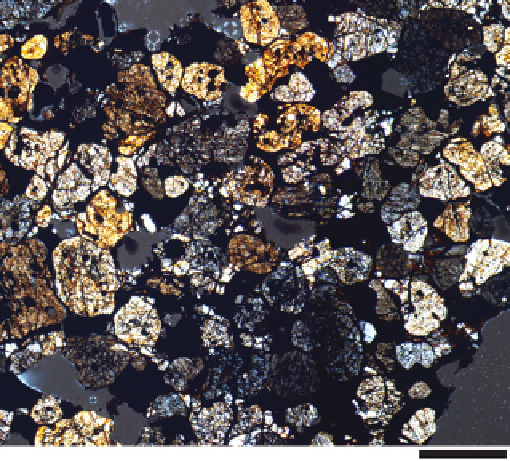Geology Reference
In-Depth Information
8.6. CHONDRITE-ACHONDRITE LINKS
It is generally accepted that differentiated asteroids and
planets began, at some point in their history, as chon-
dritic agglomerates that were subsequently processed.
With more than a dozen known types of chondrites and
a comparable or larger number of achondrites (including
the ungrouped irons; see
Mittlefehldt and McCoy
[2014
(this volume)], one of the more compelling questions in
meteoritics is whether we have any differentiated bodies
that formed by melting of known chondrites. Arguments
have been presented to link silicate-bearing IIE irons
with H chondrites and silicate-bearing IVA irons with
LL chondrites, but the study of Antarctic meteorites has
done little to augment these arguments. In contrast, one
of the most hotly debated chondrite-achondrite links is
that between the differentiated aubrites and the similarly
highly reduced enstatite chondrites. It is particularly
noteworthy that this topic continues to garner fierce
debate given that it dates to at least the earliest days of
the U.S. Antarctic meteorite program [e.g,
Watters and
Prinz
, 1979].
Enstatite chondrites and aubrites share a wide range of
similar properties, including major mineralogy, mineral
chemistry, and oxygen isotopic composition. Both formed
under highly reducing conditions in which FeO is essen-
tially absent from the mafic silicates and elements nor-
mally found in silicates combine to form exotic sulfides,
metal, and nitrides. Despite these similarities, several dif-
ferences exist between aubrites and enstatite chondrites,
with the former containing higher abundances of diop-
side and olivine, along with relatively Ti-rich troilite. A
variety of solutions have been offered to explain how
these differences could have arisen during igneous
differentiation, most involving either crystallization or
oxidation-reduction reactions. In this context, two
Antarctic meteorites are particularly relevant. Elephant
Moraine (EET) 90102 was described as the first diopside-
bearing equilibrated enstatite chondrite [
Fogel
, 1997].
Genesis of aubrites from such a protolith could help
explain the increased abundances of diopside in these
meteorites. A second meteorite relevant to this debate is
LAP 03719 (Plate 51). Most aubrites are heavily brecci-
ated, presenting a significant challenge in understanding
the lithologies present and relationships between them.
In contrast, LAP 03719 (Figure 8.2) is unbrecciated and
contains ~15 vol.% olivine.
McCoy et al
. [2005] noted that
one of the theories for olivine crystallization in aubrites,
that it was stabilized by the crystallization of roedderite
in a peralkaline melt, is inconsistent with the absence of
roedderite in LAP 03719. No further studies have been
conducted on this meteorite, and the question of whether
enstatite chondrites and aubrites are, in fact, directly
related to one another remains unresolved.
Figure 8.1.
Photomosaic of Queen Alexandra Range 94204 in
cross-polarized light. Rounded to irregular polysynthetically
twinned enstatite crystals are set in a matrix and include Fe,Ni
metal, troilite, and plagioclase. Scale bar is 1 mm. Despite
numerous petrographic descriptions, debate continues as to
whether this meteorite formed by low degrees of incipient
partial melting or complete impact melting of an enstatite
chondrite.
and lodranites, are discussed by
Mittlefehldt and McCoy
[2014 (this volume)]. Another example is the enigmatic
enstatite meteorite QUE 94204 (Figure 8.1), which is the
first recovered sample of a significant pairing group
(Plate 34). Consisting of rounded to ovoid millimeter-
sized enstatite grains with included and interstitial
metal, sulfide, and feldspar, the mineralogy is similar to
enstatite chondrites, but the texture is distinctly achon-
dritic.
Burbine et al
. [2000] argued that the presence of
zoned feldspar and polysynthetic twinning in enstatite
indicates rapid cooling, suggestive of impact melting as
the mechanism to retain the bulk chondritic composi-
tion. In contrast,
Izawa et al
. [2011] suggest that QUE
94204 formed through partial melting of an enstatite
chondrite-like protolith, analogous to the formation of
acapulcoites and lodranites, although these authors
could not unambiguously rule out impact melting.
Recently,
van Niekerk and Keil
[2012] compared the two
competing hypotheses for the formation of the QUE
94204 pairing group and favored an impact melt origin.
Despite the extensive petrologic studies referenced
above, the petrogenesis of these meteorites is still
unclear, yet the issue of impact versus indigenous
melting of asteroids remains one of the central ques-
tions in understanding the melting of asteroids in the
early history of the solar system.

